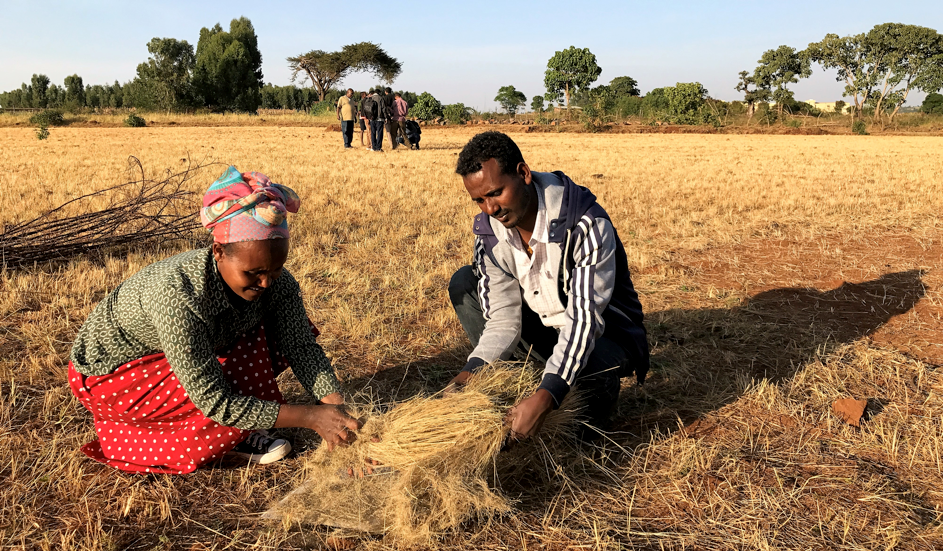The big picture: using wildflower strips for pest control
Whether a child in sub-Saharan Africa develops serious health problems because of a poor diet is essentially a ‘postcode lottery’, according to a major new international study.
A joint Africa-UK research team analysed thousands of cereal grains and soils as part of a project to tackle so called ‘hidden hunger’ in Malawi and Ethiopia, where they found large geographical variation in micronutrients in staple cereal grains, a finding which has important implications for childhood development.
For people in rural areas where locally sourced food predominates, the area they live in will be the largest influencing factor in determining their dietary intake of minerals such as calcium, iron, selenium, and zinc.
Globally, more than two billion people are affected by one or more micronutrient deficiencies with greater deficiency risks in South Asia and sub-Saharan Africa than in most other regions.
It affects more than half of all under-fives, and poses a serious risk to health, including impaired growth and cognitive development, and susceptibility to infectious and non-communicable diseases.
Published in Nature, these are the first surveys of cereal grain micronutrient composition in sub Saharan Africa at a within-country scale, and according to one of Rothamsted’s co-authors, Dr Stephan Haefele, they are an important step in being able to target the localities most affected by hidden hunger.
“Estimates of hidden hunger require reliable food micronutrient composition data. National or international food composition tables are routinely used in sub-Saharan Africa. However, composition data are typically limited to single values for each food and nutrient combination and are therefore of limited value for exploring the geographical variation in micronutrient intake.
“This is problematic given the widespread consumption of locally produced staple foods such as cereal grains among smallholder farming communities and that food micronutrient composition varies so much within countries.
Surveillance of hidden hunger could be improved using more localised grain micronutrient composition data, he added.
“Beyond dietary diversification, interventions to alleviate hidden hunger, such as dietary supplements, food fortification and biofortification of crops could tackle these geographical effects.”

Studying more than 3000 cereal crop and soil samples, the team showed substantially variation with location, with some areas showing much lower levels of micronutrients than others.
Researchers sampled grain and soil across 354,000 km2 of cultivated land in Ethiopia, representative of most of its cereal growing area.
Further analysis showed there were clear localised relationships between grain selenium concentration and the amount of selenium in blood samples taken across both countries.
Soil and environmental covariates of grain micronutrient concentration included soil pH, soil organic matter, temperature, rainfall, and topography, which were specific to micronutrient and crop type.
The paper furthers Rothamsted’s long standing involvement in hidden hunger research and was possible due to the Institute’s analytical expertise – the same expertise which made last year’s landmark soil map of sub-Saharan Africa possible.
The project was funded primarily by the Bill & Melinda Gates Foundation, and led by Professor Martin Broadley, who is soon to join Rothamsted from his current role at the University of Nottingham.
He said: “It is important to have good quality evidence on the nutritional quality of diets if we are going to support public health and agriculture policies to improve peoples’ health and wellbeing. Mapping the quality of diets is an important part of this evidence.”
The co-lead authors of the paper are Dr Dawd Gashu, from Addis Ababa University, and Dr Patson Nalivata, from at Lilongwe University of Agriculture and Natural Resources.
Other partners in this project include the London School of Hygiene & Tropical Medicine (LSHTM), and the British Geological Survey (BGS) in the UK.
International partners include the College of Medicine (University of Malawi), International Maize and Wheat Improvement Centre (CIMMYT), International Crops Research Institute for the Semi-Arid Tropics (ICRISAT), and the World Agroforestry Centre (ICRAF).
The investment from the Gates Foundation was supported by projects funded by the UK Government via the UKRI’s Global Challenges Research Fund, the Royal Society, the Foreign, Commonwealth and Development Office, and the Biotechnology and Biological Sciences Research Council.

Systems Agronomist

Soil and Plant Scientist
Rothamsted Research is the longest-running agricultural research institute in the world. We work from gene to field with a proud history of ground-breaking
discoveries in areas as diverse as crop management, statistical interpretation and soil health. Our founders, in 1843, were the pioneers of modern
agriculture, and we are known for our imaginative science and our collaborative approach to developing innovative farm practice.
Through independent research, we make significant contributions to improving agri-food systems in the UK and internationally, with
economic impact estimated to exceed £3 bn in annual contribution to the UK economy. Our strength lies in our systems approach, which combines strategic research,
interdisciplinary teams and multiple partnerships.
Rothamsted is home to three unique National Bioscience Research Infrastructures which are open to researchers from all over the world:
The Long-Term Experiments,
Rothamsted Insect Survey and the
North Wyke Farm Platform.
We are strategically funded by the Biotechnology and Biological Sciences Research Council (BBSRC), with additional support from other national and
international funding streams, and from industry. We are also supported by the Lawes Agricultural Trust (LAT).
The Biotechnology and Biological Sciences Research Council is part of UK Research and Innovation, a non-departmental public body funded by a grant-in-aid
from the UK government.
BBSRC invests to push back the frontiers of biology and deliver a healthy, prosperous and sustainable future. Through our investments, we build and support a vibrant,
dynamic and inclusive community which delivers ground-breaking discoveries and develops bio-based solutions that contribute to tackling global challenges,
such as sustainable food production, climate change, and healthy ageing.
As part of UK Research and Innovation (UKRI), we not only play a pivotal role in fostering connections that enable the UK’s world-class research and innovation system
to flourish – we also have a responsibility to enable the creation of a research culture that is diverse, resilient, and engaged.
BBSRC proudly forges interdisciplinary collaborations where excellent bioscience has a fundamental role. We pioneer approaches that enhance the equality, diversity,
and inclusion of talent by investing in people, infrastructure, technologies, and partnerships on a global scale.
The Lawes Agricultural Trust, established in 1889 by Sir John Bennet Lawes, supports Rothamsted Research’s national and international agricultural science through the provision of land, facilities and funding. LAT, a charitable trust, owns the estates at Harpenden and Broom's Barn, including many of the buildings used by Rothamsted Research. LAT provides an annual research grant to the Director, accommodation for nearly 200 people, and support for fellowships for young scientists from developing countries. LAT also makes capital grants to help modernise facilities at Rothamsted, or invests in new buildings.